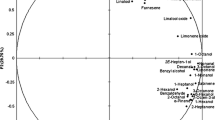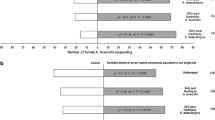Abstract
Galerucella placida Baly (Coleoptera: Chrysomelidae) is a potential biocontrol agent of the rice-field weed Polygonum orientale L. (Polygonaceae). The volatile organic compound (VOC) profiles from undamaged and mechanically damaged plants, and from plants 12- and 36-h following continuous feeding of female G. placida adults and 2nd instar larvae were identified and quantified by GC–MS and GC-FID analyses. Twenty-four and 21 compounds were identified in volatiles of undamaged and insect feeding plants, respectively; whereas 22 compounds were detected in volatiles of mechanically damaged plants. Decanal and 1-dodecanol were unique to undamaged plants, and linalool was detected in volatiles of undamaged and mechanically damaged plants, but not in volatiles of insect damaged plants. However, the beetles are not attracted by none of these volatile components, when tested individually in Y-shaped glass tube olfactometer bioassays. In all plants, methyl jasmonate was predominant. 1-Undecanol was the least amount in undamaged plants, and plants 12-h after feeding by G. placida adults and larvae; whereas 1-tridecanol was the least abundant in plants 36-h after feeding by G. placida adults and larvae, and mechanically damaged plants. The beetles showed significant preference to the whole volatile blends from plants 12-h after feeding by larvae and plants 36-h after feeding by either larvae or adults compared to those of undamaged plants. Further, G. placida responded to individual synthetic compounds, 3-hexanol, 1-octen-3-ol, nonanal, and geraniol at 7, 1.38, 3.75 and 4.5 µg/25 µL CH2Cl2, respectively, and provide a basis for attraction of the potential biocontrol agent in the field.






Similar content being viewed by others
References
Adhikary P, Mukherjee A, Barik A (2015) Attraction of Callosobruchus maculatus (F.) (Coleoptera: Bruchidae) to four varieties of Lathyrus sativus L. seed volatiles. Bull Entomol Res 105:187–201
Baharum SN, Bunawan H, Ghani MA, Mustapha WAW, Noor NM (2010) Analysis of the chemical composition of the essential oil of Polygonum minus Huds. using two-dimensional gas-chromatography-time-of-flight mass spectrometry (GC-TOF MS). Mol. doi:10.3390/molecules15107006
Beenen R (1998) Galerucella placida a proper species from south east Asia (Coleoptera: Chrysomelidae: Galerucinae). Serangga 3:107–110
Bolter CJ, Dicke M, van Loon JJA, Visser JH, Posthumus MA (1997) Attraction of Colorado potato beetle to herbivore-damaged plants during herbivory and after its termination. J Chem Ecol 23:1003–1023
Bruce TJA, Pickett JA (2011) Perception of plant volatile blends by herbivorous insects—finding the right mix. Phytochemistry 72:1605–1611
Bruce TJA, Wadhams LJ, Woodcock CM (2005) Insect host location: a volatile situation. Trends Plant Sci 10:269–274
Creelman RA, Mullet JE (1997) Biosynthesis and action of jasmonates in plants. Annu Rev Plant Physiol Plant Mol Biol 48:355–381
Datta SC, Chatterjee AK (1980) Allelopathy in Polygonum orientale: inhibition of seed germination and seedling growth of mustard. Comp Physiol Ecol 5:54–59
De Moraes CM, Lewis WJ, Paré PW, Alborn HT, Tumlinson JH (1998) Herbivore infested plants selectively attract parasitiods. Nature 393:570–573
Ding J, Fu W, Reardon R, Wu Y, Zhang G (2004) Exploratory survey in China for potential insect biocontrol agents of mile-a-minute weed, Polygonum perfoliatum L., in Eastern USA. Biol Con 30:487–495
Farmer EE, Ryan CA (1990) Interplant communication: airborne methyl jasmonate induces synthesis of proteinase inhibitors in plant leaves. Proc Natl Acad Sci USA 87:7713–7716
Hare JD (2011) Ecological role of volatiles produced by plants in response to damage by herbivorous insects. Annu Rev Entomol 56:161–180
Hnatiuk RJ (1990) Australian Flora and Fauna. Series Number 11. Census of Australian Vascular Plants. Australian Government Publishing Service, Canberra
Jiang J (2005) Volatile composition of the laksha plant (Polygonum hydropiper L.), a potential source of green note aroma compounds. Flav Fragr J 20:455–459
Kim Y-S, Hwang C-S, Shin D-H (2005) Volatile constituents from the leaves of Polygonum cuspidatum S. et Z. and their anti-bacterial activities. Food Microbiol 22:139–144
Kimoto S (1989) Chrysomelidae (Coleoptera) of Thailand, Cambodia. Laos and Vietnam. IV. Galerucinae. Esakia 27:1–241
Kugimiya S, Shimoda T, Tabata J, Takabayashi J (2010) Present or past herbivory: a screening of volatiles released from Brassica rapa under caterpillar attacks as attractants for the solitary parasitoid, Cotesia vestalis. J Chem Ecol 36:620–628
Landolt PJ, Tumlinson JH, Alborn DH (1999) Attraction of Colorado potato beetle (Coleoptera: Chrysomelidae) to damaged and chemically induced potato plants. Environ Entomol 28:973–978
Legendre P, Legendre L (1998) Numerical ecology. Elsevier, Oxford
Magalhães DM, Borges M, Laumann RA, Sujii ER, Mayon P, Caulfield JC, Midega CAO, Khan ZR, Pickett JA, Birkett MA, Blassioli-Moraes MC (2012) Semiochemicals from herbivory induced cotton plants enhance the foraging behaviour of the cotton boll weevil, Anthonomus grandis. J Chem Ecol 38:1528–1538
Malik U, Barik A (2015) Free fatty acids from the weed, Polygonum orientale leaves for attraction of the potential biocontrol agent, Galerucella placida (Coleoptera: Chrysomelidae). Biocontrol Sci Tech 25:593–607
Maulik S (1936) The fauna of British India, including Ceylon and Burma. Coleoptera. Chrysomelidae (Galerucinae). London: Taylor and Francis
Mukherjee A, Sarkar N, Barik A (2015) Momordica cochinchinensis (Cucurbitaceae) leaf volatiles: semiochemicals for host location by the insect pest, Aulacophora foveicollis (Coleoptera: Chrysomelidae). Chemoecology 25:93–104
Mumm R, Dicke M (2010) Variation in natural plant products and the attraction of bodyguards involved in indirect plant defense. Can J Zool 88:628–667
Padovan A, Keszei A, Köllner TG, Degenhardt J, Foley WJ (2010) The molecular basis of host plant selection in Melaleuca quinquenervia by a successful biological control agent. Phytochemistry 71:1237–1244
Paré PW, Tumlinson JH (1996) Plant volatile signals in response to herbivore feeding. Florida Entomol 79:93–103
Paré PW, Tumlinson JH (1999) Plant volatiles as a defense against herbivores. Plant Physiol 121:325–331
Piesik D, Pańka D, Delaney KJ, Skoczek A, Lamparski R, Weaver DK (2011) Cereal crop volatile organic compound induction after mechanical injury, beetle herbivory (Oulema spp.), or fungal infection (Fusarium spp.). J Plant Physiol 168:878–886
Piesik D, Wenda-Piesik A, Ligor M, Buszewski B, Delaney KJ (2012) Dock leaf beetle, Gastrophysa viridula Deg., herbivory on the mossy sorrel, Rumex confertus Willd: induced plant volatiles and beetle orientation responses. J Agric Sci 4:97–103
Prokopy RJ, Owens ED (1983) Visual detection of plants by herbivorous insects. Annu Rev Entomol 28:337–364
Reid CAM (2001) Galerucella placida Baly in Australia (Coleoptera: Chrysomelidae: Galerucinae). Aust J Entomol 40:331–334
Riffell JA, Lei H, Christensen TA, Hilderbrand JG (2009) Characterization and coding of behaviourally significant odor mixtures. Curr Biol 19:335–340
Rojas JC, Wyatt TD (1999) Role of visual cues and interaction with host odour during the host-finding behaviour of the cabbage moth. Entomol Exp Appl 91:59–65
Sarkar N, Mukherjee A, Barik A (2015) Attraction of Epilachna dodecastigma (Coleoptera: Coccinellidae) to Momordica charantia (Cucurbitaceae) leaf volatiles. Canad Entomol 147:169–180
Schoonhoven LM, van Loon JJA, Dicke M (2005) Insect–plant biology. Oxford University Press, Oxford
Smith L, Beck JJ (2013) Effect of mechanical damage on emission of volatile organic compounds from plant leaves and implications for evaluation of host plant specificity of prospective biological control agents of weeds. Biocontrol Sci Tech 23:880–907
Tabata J, DeMoraes CM, Mescher MC (2011) Olfactory cues from plants infected by powdery mildew guide foraging by a mycophagous ladybird beetle. PLoS One 6(8):e23799. doi:10.1371/journal.pone.0023799
Tasin M, Bäckman AC, Anfora G, Carlin S, Ioriatti C, Witzgall P (2010) Attraction of female grapevine moth to common and specific olfactory cues from 2 host plants. Chem Senses 35:57–64
Turlings TC, Tumlinson JH (1992) Systemic release of chemical signals by herbivore-injured corn. Proc Natl Acad Sci USA 89:8399–8402
Turlings TCJ, McCall PJ, Alborn HT, Tumlinson JH (1993) An elicitor in caterpillar oral secretions that induces corn seedlings to emit chemical signals attractive to parasitic wasps. J Chem Ecol 19:411–425
Van den Dool H, Kratz PD (1963) A generalization of the retention index system including linear temperature programmed gas-liquid partition chromatography. J Chromatogr A 11:463–471
Webster B, Bruce T, Pickett J, Hardie J (2010) Volatiles functioning as host cues in a blend become nonhost cues when presented alone to the black bean aphid. Anim Behav 79:451–457
Wheeler GS, Schaffner U (2013) Improved understanding of weed biological control safety and impact with chemical ecology: a review. Invasive Plant Sci Manage 6:16–29
Zar JH (1999) Biostatistical analysis. Pearson Education Inc., New Delhi
Zhang Z-Q, McEvoy PB (1995) Responses of ragwort flea beetle Longitarsus jacobaeae (Coleoptera: Chrysomelidae) to signals from host plants. Bull Entomol Res 85:437–444
Zhang YT, Zhang YL, Chen SX, Yin GH, Yang ZZ, Lee S, Liu CG, Zhao DD, Ma YK, Song FQ, Bennett JW, Yang FS (2015) Proteomics of methyl jasmonate induced defense response in maize leaves against Asian corn borer. BMC Genom 16:224. doi:10.1186/s12864-015-1363-1
Acknowledgments
We thank Dr. Thomas Schmitt and anonymous reviewer(s) for helpful suggestions of an earlier version of the manuscript. We are thankful to C. L. Staines, National Museum of Natural History, Smithsonian Institution, Washington DC for identifying the insect, and Prof. Ambarish Mukherjee of this University for identification of the weed. The financial assistance from the University Grants Commission (UGC), New Delhi, India as a JRF (F1-17.1/2013-14/RGNF-2013-14-SC-WES-38778/(SA-III/Website) to UM is gratefully acknowledged.
Author information
Authors and Affiliations
Corresponding author
Additional information
Handling Editor: Thomas Schmitt.
Electronic supplementary material
Below is the link to the electronic supplementary material.
Rights and permissions
About this article
Cite this article
Malik, U., Karmakar, A. & Barik, A. Attraction of the potential biocontrol agent Galerucella placida (Coleoptera: Chrysomelidae) to the volatiles of Polygonum orientale (Polygonaceae) weed leaves. Chemoecology 26, 45–58 (2016). https://doi.org/10.1007/s00049-015-0206-5
Received:
Accepted:
Published:
Issue Date:
DOI: https://doi.org/10.1007/s00049-015-0206-5




